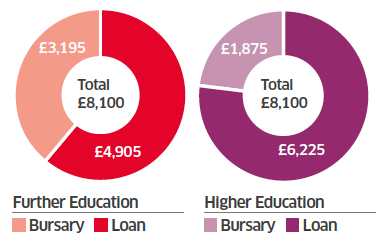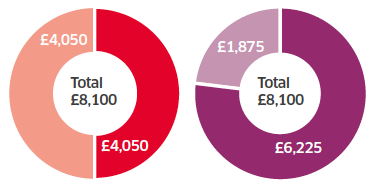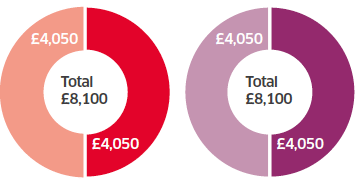Student financial support in Scotland: independent review
Recommendations for improving the higher and further education student support system.
Summary by Independent Chair

Highlights
- A New Social Contract for Students
- Minimum Student Income entitlement in both further and higher education
- Minimum Student Income of £8,100
- Increased means-tested bursaries; and discretionary funds protected
- Student loans enhanced, including an increased loan repayment threshold
- Student loans available in further education
- Debt write-off for students transitioning from further to higher education
- Common systems of administration within further and higher education
- A new approach for students on benefits
Background
When I was asked, almost 12 months ago, to Chair this independent review into student support in Scotland, the politics of student funding was much less acute across the United Kingdom than it is today.
The Scottish Government already funds tuition fees and rightly wanted to consider how they may be able to improve the provision of living costs for students. Better financial support would encourage students from all backgrounds to enter further and higher education, with confidence and clarity about their entitlement to funding.
But the Scottish Government also made it clear in the remit that any recommendations from the Review should be made in full awareness “ of the evident constraint on the public finances”.
As a result of its comprehensive and independent review of the current system, the Student Support Review Board has considered how to support students fairly, whatever their circumstances and whatever their chosen educational path.
Our recommendations are grounded in meaningful and up to date evidence, gathered from extensive interactions with students and key stakeholders across Scotland.
The Board has also considered various options for how student support could be funded. We have reached a broad consensus which is reflected in our recommendations. I am very grateful to each member of the Board for their time, input, challenge and support.
Education and society
As we grappled with a seemingly daunting list of issues, it was helpful to focus on the true value of education. Of course, education is essential for the economic development and sustainability of Scotland – it is estimated that every £1 of public investment in further and higher education leads to almost £6 of economic impact.
But it is also vital for the social good of our country. Effective societies invest in education for its own sake as well as for productivity and prosperity.
This seems to me hugely important in today’s world with its constant changes and challenges. Globalisation, populism and digitisation, added to the traditional social and economic challenges of our society all drive a need for capable and well-educated people – to grow, develop and lead us to peaceful prosperity and economic success.
For me, this means that all education should be valued equally and all students treated with equity, regardless of social background.
In other words, parity is vital. Whether in further education in Scotland’s thriving college sector, or higher education in our historic and newer universities and colleges, students need a level playing field to access the necessary financial support to commence and complete their studies. They need to be confident of relying on a fair standard of living whilst they study. This can help to close the attainment gap and create an environment where students are motivated to give back to the society that supported them.
What we are proposing, therefore, is nothing short of a New Social Contract for Scotland’s students.
The New Social Contract for Students – fair funding, parity and clarity
In summary, the New Social Contract for Students proposes guaranteed funding for our students at a decent minimum level, with parity across educational sectors and with clarity in terms of what is available to each student at all times.
The principles which underpin the New Social Contract apply to all students – full-time, part‑time, supported, independent, estranged, disabled, student parents, carers and care experienced students. And whilst our recommendations focus primarily on full-time students, further work should be carried out to enable the recommendations to be implemented for all students.
Fair funding
Under the New Social Contract, students in both further and higher education will be entitled to an amount based on the Scottish Government’s Living Wage [1] . For most full-time students we calculate this to be £8,100 for each academic year of study.
This is a step change particularly for students in further education, who currently have no guaranteed entitlement to funding and no ability to access student loans.
Students should have more flexibility around when they receive their money depending on their personal requirements. For example, they could choose a per term or a monthly basis, with the option of spreading payments over twelve equal instalments. This could help students to manage their money, especially over the summer months.
This income can be augmented by employment in addition to normal studies. We support the recommendations of the Cubie Review [2] that employment should ideally be for no more than ten hours a week during term time.
Discretionary funding, for example for hardship, disability or carers, should also be retained.
What will students give in return?
Students will commit to attend their courses, meet their academic obligations and take responsibility for budgeting and managing their funding. However, the current attendance rules in further education are cumbersome and bureaucratic and should be streamlined like those in higher education. Guidelines for a workable arrangement in such cases should be agreed at a national level and administered at a local level. The approach should be flexible and fair and adhered to by students.
Interaction with benefits
Some students are entitled to receive benefits. It is our intention that no student should lose their benefit entitlements because they are in receipt of student funding. As a result, we propose that Scotland develops a new Special Support Payment for these students, similar to that already adopted in England, Wales and Northern Ireland. We recommend that the implementation of this is discussed between the Scottish and Westminster Governments.
Common systems approach
Common administration systems should be developed to deliver funding consistently to all students within further and higher education. The face-to-face support currently operated predominantly in the college sector should be maintained and extended for all students, to provide them with pastoral as well as financial guidance and administrative support.
Clarity – information, advice and guidance
It is vital that the available financial support should be communicated clearly and consistently to students and to their support networks.
I have been surprised by the lack of understanding of the financial support that is available to students and this should be straightforward to address. This Report contains recommendations to remedy this issue.
Additional focus in schools on financial support and financial management for both pupils and parents is also a recommendation of this Review.
Cost – what will the New Social Contract cost and how will it be financed?
The introduction of an entitlement to funding at a level equivalent to the Scottish Government’s Living Wage will require a major change in approach.
Currently some students in further education receive discretionary means-tested grants known as bursaries – with an average maximum of £3,195 – but these students are not eligible for student loans. Other further education students receive no guaranteed funding assistance from their college.
In higher education, some students are entitled to smaller bursaries – up to a maximum of £1,875 – but all students can benefit from a student loan.
It is clear that we need to take a fresh look at student loans.
Student loans in Scotland – understanding the context
Student loans have received some bad press recently, particularly elsewhere in the United Kingdom. There is evident concern amongst many Scottish families that student loans should be avoided, as it is perceived that they trap students with a long term debt burden. This concern is shared by a number of members of the Board.
However, should our recommendations be implemented, student loans in Scotland would offer the best terms that are available anywhere in the United Kingdom. Student loans offer more generous terms for students than are available through banks, loan companies or payday lenders. The interest rates are low and repayment terms are very favourable. Loans are repayable only when the individual earns a reasonable graduate salary. And students in Scotland are not required, as they are in other parts of the United Kingdom, to fund tuition fees through loans or otherwise.
We found that some students who avoided student loans were later compelled to borrow through expensive forms of credit such as payday lenders. The Board agreed that this outcome should always be avoided, especially when borrowing is available on much more reasonable terms through student loans.
The key questions are therefore:
- how do we make student loans as beneficial for students as possible?
- what is the right balance between loans and means-tested bursaries to meet the £8,100 Minimum Student Income guarantee for students?
We considered these questions and identified three issues:
The quality of lending terms available in Scotland
The Scottish National Party committed in its Manifesto to enhance the terms of student loans. On the basis of that commitment we recommend that student loans are:
- charged at lower of either 1% over Bank of England base rate or RPI (Retail Price Index). For comparison, interest rates on Scottish student loans are currently 1.25%, whereas in England they are between 3% and 6% – depending on earnings.
- repaid only when a student earns £22,000 – the median graduate salary in Scotland. The Scottish Government should consider increasing this to £25,000 based on current proposals in England. This additional increase would cost around £27m per year.
- written off in full to the extent they are unpaid after 30 years rather than the current 35 year period.
We believe that student loans on these terms would give students in Scotland access to preferential lending in order to support their education. Coupled with the lack of need to borrow to pay tuition fees in Scotland, these loan arrangements would be the most generous in the United Kingdom.
Who should receive a student loan?
There was much discussion by the Board about whether students in further education should be eligible for student loans. For me, the principle of parity means an entitlement to funding at the level of £8,100 should be made available to students in both further and higher education.
Realistically, within the current funding options available, I believe this will require the introduction of student loans to further education students to top up existing levels of bursary. And bursaries should continue to be means-tested to focus non-repayable financial support on those from the lowest income backgrounds. The current threshold for means-testing in further and higher education should be harmonised over time.
I absolutely understand the concerns of some Board members regarding the introduction of loans to further education students. To balance these concerns, it is vitally important to ensure that student loans are made available only on the best possible terms, as I have described. In addition, we also recommend that further education loans should be written off in full if the student goes on to higher education and completes their higher education course. Approximately 11,600 students follow this path in Scotland today and our costings continue to assume that this pattern continues. Further work will be required to scope out the precise terms of the write-off in order to ensure a fair and consistent approach for all students.
The pathway to funding: how should levels of loans and bursaries be balanced?
This was arguably the hardest question we considered. The Board found it helpful to view the costs landscape as a journey to be achieved over time. However, the rate of progress to fair funding and parity is for the Scottish Government to determine based on the public funding they wish to allocate in any particular year.
Some Board members would prefer that no loans be used to fund either further or higher education, with students instead receiving non-means tested bursaries of £8,100. We costed this at £459m per year more than the current bursary spend. The general consensus was, however, that this outcome could not be pursued within the terms of this Review. Nevertheless, it was helpful to have the debate, particularly as this was an aspirational outcome for both NUS Scotland and UNISON.
We identified three options, with associated costs. In each case the additional cost of student loans is described as notional as there is no immediate direct cash cost, but rather future write-downs to student loans. We understand that the Scottish Government has headroom to consider increasing the use of student loans within existing allocations from the United Kingdom Government.
1 – Status quo for bursaries

One option would be for current bursary amounts to be maintained and the proposed £8,100 minimum income for students to be achieved by additional funding through student loans. This would meet the budgetary remit of the Review and have a zero additional direct bursary cost to the Scottish Government.
The split between loans and bursaries across further and higher education for those from the lowest income backgrounds is shown above.
This proposal would not increase direct bursary spend, but would notionally cost £252m per year more for additional student loans.
2 – Hybrid approach

A further step on the journey could be to equalise bursary and loan for further education students at £4,050 for each element. Higher education students from the lowest income backgrounds would continue with the current maximum bursary of £1,875, with the remainder in loan. This is shown above.
This approach would increase the direct bursary cost for further education students by £16m per year. In addition, it would increase the notional cost of student loans, if the maximum was drawn, by £231m per year.
3 – 50/50 bursary to loan balance

Following the parity principle, it was an aspiration of most of the Board that further and higher education students receive £8,100 a year in minimum income, allocated for those from the lowest income backgrounds at 50% through bursary and 50% through loan – as shown above.
This would cost the Scottish Government an additional £123m per year in direct bursary cost and would increase the notional cost of student loans by £153m per year.
We considered the pros and cons of each of these approaches:
Option 1 (status quo for bursaries) provides funding to the level of the Scottish Government’s Living Wage through the increased use of student loans at no additional direct bursary cost. This option, on its own, is not our recommendation as it relies too heavily on student loans.
We believe the Scottish Government should move beyond Option 1, through the use of increased bursaries. Option 2 calls for a 50/50 split of bursary to loan in further education only, resulting in a relatively modest additional direct bursary cost of £16m per year. This option does not create immediate parity in bursaries across further and higher education, but it does help to manage the introduction of student loans into further education.
To the extent that additional public funding is allocated, we believe that bursaries should be increased to balance student loans. Option 3 would give an equal balance of bursaries and loans in both further and higher education at an indicative additional direct bursary cost of £123m per year.
Given the terms of the remit of this Review, Board members believe that the Scottish Government should adopt Option 2, which provides:
- an immediate and meaningful improvement in funding to students across further and higher education;
- equal split of bursaries and loans for the poorest students in further education to support the introduction of student loans;
- protection of existing bursaries in higher education; and
- access to high quality student loans.
The direct additional cost would be £16m per year.
Recognising the aspiration of some of the Board to move beyond this point, particularly NUS Scotland and UNISON, the Scottish Government may wish to consider Option 3, costing an additional £123m per year.
Conclusion
The Scottish Government’s focus on funding tuition fees for social and economic prosperity is to be commended.
Based on the work of the Student Support Review Board, we recommend that this focus is channelled into creating a New Social Contract for Students in Scotland. This contract will deliver:
- fair funding with a Minimum Student Income entitlement for Scottish domiciled students studying in Scotland, based on the Scottish Government’s Living Wage of £8,100;
- parity of treatment for students of all backgrounds, whether they are in further or higher education; and
- clarity of systems and communications to ensure that students and parents fully understand the financial support available.
The increase in financial support for students can be delivered predominantly through the additional availability of high quality student loans. To the extent that more public funding is allocated, there is the potential to increase bursaries.
And in return, more students from diverse backgrounds will have the chance to become successful graduates, for the social and economic good of Scotland.
We also recommend that the Scottish Government works in collaboration with other interested parties, to look at how the key principles of this Review should be best implemented for part-time students and those currently receiving Education Maintenance Allowance ( EMA).
We invite the Scottish Government to accept these recommendations in full.
I would like to thank the Student Support Review Board, the support team and all those who have taken the time to provide evidence or to respond to this Review.
Jayne-Anne Gadhia, CBE
Independent Chair
Student Support Review in Scotland
Student Support Review Board
John Gallacher
Scottish Organiser, lead for Further Education, UNISON Scotland
Russell Gunson
Director, IPPR Scotland
Luke Humberstone
President, NUS Scotland*
Dr John Kemp
Interim Chief Executive, Scottish Funding Council
Paul Lowe
Chief Executive, SAAS
Yvonne MacDermid OBE
Chief Executive, Money Advice Scotland
Louise Macdonald OBE
Chief Executive, Young Scot
Annag MacLean
former Head Teacher, Castlebay Community School, Barra
Erin McAuley
Student and former member of Scottish Youth Parliament
Alastair Sim
Director, Universities Scotland
Linda Somerville
Director, NUS Scotland*
Shona Struthers
Chief Executive, Colleges Scotland
Angela Toal
Welfare Rights Worker, Child Poverty Action Group
* NUS Scotland was represented by Vonnie Sandlan and Philip Whyte until June 2017
Remit of the review
The Review’s overall remit was to assess the effectiveness of the current system of student support for all students engaged in further and higher education in Scotland, and to make recommendations for beneficial change.
The Minister for Further Education, Higher Education and Science, Shirley-Anne Somerville MSP, made clear that the focus of this Review was living cost support for students in Scotland. The Scottish Government policy on free tuition was not within scope. The Review was asked to be bold and inquisitive, and to be aware “of the evident constraint on the public finances”.
Our approach in the time available was to undertake a holistic review from a policy perspective. It is necessarily high-level and we have focused on getting the core offer right. The recommendations are based on the Board’s assessment of the evidence gathered, and will improve the fairness and effectiveness of student support. We acknowledge that additional work will be needed on the impact on part-time students.
Basis of costings
All calculations are based on publicly available data and information from the Scottish Government via the Student Funding Council ( SFC) and the Student Awards Agency Scotland ( SAAS). This financial information was provided from January to August 2017. The data available at the time the Board considered the costings in September 2017 was from the 2015-16 academic year.
The lack of common data available for further education meant that some assumptions were required, based on macro-economic data. Scottish Government officials checked the calculations prepared for the Board and confirmed that the assumptions appeared reasonable. The Living Wage calculations are based on the Scottish Government’s 2016-17 Living Wage of £8.45 per hour (at the time of the final Board meeting on 26 October 2017).
Areas out of scope for the Review:
- Tuition fees in Scotland
- Funding for postgraduate studies
- Nursing and midwifery students
- Bursaries for training from industry
- Specific discretionary bursaries and scholarships for individual institutions
Contact
There is a problem
Thanks for your feedback